Two front splicing methods and safety precautions with each
The previous article in this series presented an overview of splicing and two rear splicing methods. This article will conclude the series by describing two front splicing methods.

 |
DANGER: Front splicing procedures have more danger of crush injuries from rotating nips than rear splicing procedures. Be very careful when working near the rotating drums. To avoid crush injuries, keep hands, body, and clothes away from the nip formed by the front drum and the roll set. Do not activate equipment without knowing that all participants are clear of nips, familiar with their tasks, and ready to proceed. Maintain unrestricted visibility of all participants and moving equipment. The boldface text NIP HAZARD will appear next to steps which require extra caution. |

NOTE: Some windup sections have a local control (button, switch, or footswitch) which must be held to initiate winder movement. Movement will stop as soon as the control is released. When all safety devices and procedures are used as designed, this is the only control which will activate winder movement during a front splicing procedure.

 |
DANGER: Do not disable or bypass the conditions which require the use of local controls, or the programmed safety interlocks. These are in place to minimize the hazards associated with splicing procedures. The person controlling the drum / unwind rotation is responsible for supervising all participants and steps involved in the splicing procedure. |

Front splicing (method 1)
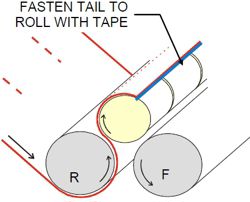
2. Stop the winder and approach the drum pocket.
3. Fasten the tail to the paper rolls with tape.
4. NIP HAZARD! Wrap a couple of layers of paper onto the rolls at thread speed until the web is straight and wrinkle-free. Keep the web tension uniform and at least half the normal operating tension.
5. Engage the slitters.
6. NIP HAZARD! Rotate the winder at thread speed until the slit web reaches the rolls.
7. Stop the winder.
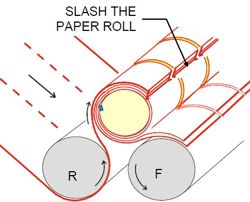
NOTE: All rolls must be slashed to an equal depth. Roll diameters must remain equal after the wrinkled and damaged paper is removed or else the rider roll load will not be distributed evenly against all the rolls.
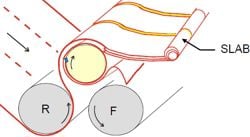
10. Stop the winder when the slash mark on the end of the roll reaches the top and all of the damaged paper has been removed from around the rolls.
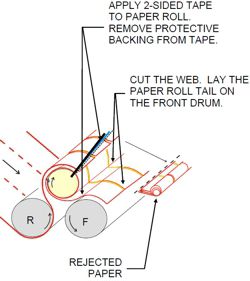
12. Draw the other paper tail from under the surface layer and place it evenly on the front drum.
13. Straighten the tails of the threaded webs where they lie on the paper roll. Apply 2-sided splice tape at an angle from one end of the paper roll to the other, wrapping the tape over both roll ends. Tear a clean edge along the tape line. Make sure that the webs do not move or wrinkle during the taping or tearing process.
14. Remove the protective backing from the tape.
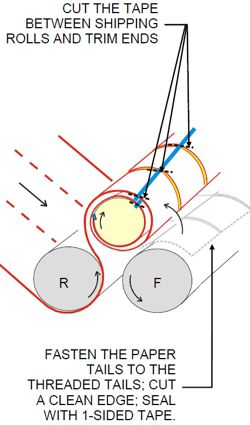
16. Cut off the excess tape length from the ends of the set, and cut the tape between the individual rolls.
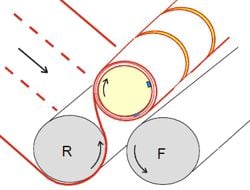
18. Have all personnel exit the winder area. Reset all safety circuits.
19. Run the winder at thread speed for a short time, then resume run speed.
Front splicing (method 2)

2. Stop the winder and approach the drum pocket.
3. Fasten the tail to the paper rolls with tape.
4. NIP HAZARD! Wrap a couple of layers of paper onto the rolls at thread speed until the web is straight and wrinkle-free. Keep the web tension uniform and at least half the normal operating tension.
5. Engage the slitters.
6. NIP HAZARD! Rotate the winder at thread speed until the slit web reaches the rolls.
7. Stop the winder.
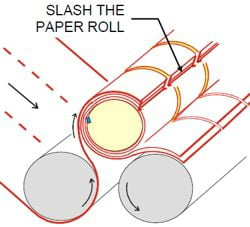
NOTE: All rolls must be slashed to an equal depth. Roll diameters must remain equal after the wrinkled and damaged paper is removed. Otherwise the rider roll load will not be distributed evenly against all the rolls.
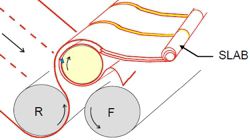
10. Stop the winder when the slash mark on the end of the roll reaches the top and all of the damaged paper has been removed from around the rolls.
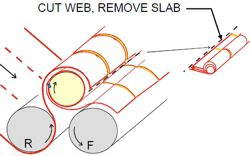
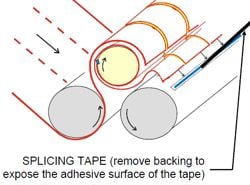
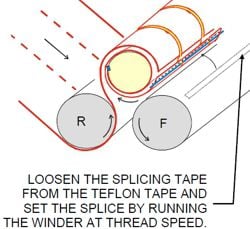
14. NIP HAZARD! Rotate the winder at thread speed until the splicing tape goes through the drum nips.
15. NIP HAZARD! Carefully, push the excess paper layer(s) aside while the drums rotate.
16. Stop the winder when the tape reaches a suitable handling height.
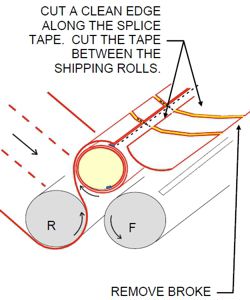
18. Cut the tape between the rolls.
19. Remove broke from the winder.
20. Have all personnel exit the winder area. Reset all safety circuits.
21. Run the winder at thread speed for a short time, then resume run speed.
For more information on safe and efficient splicing operations, contact your Valmet representative.